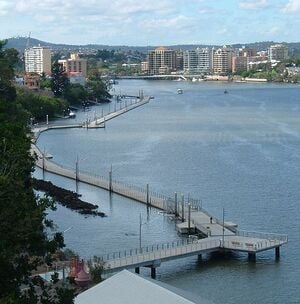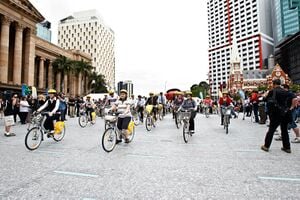
 First Nations woman one of seven global winners of prestigious Goldman prize for environmental activism, theguardian.com (Apr 29, 2024)
First Nations woman one of seven global winners of prestigious Goldman prize for environmental activism, theguardian.com (Apr 29, 2024)  As the First Nations know, forests are ‘music to the soul’, positive.news (Apr 03, 2024)
As the First Nations know, forests are ‘music to the soul’, positive.news (Apr 03, 2024)
Ecovillages[edit | edit source]
- Maleny Eco Village on ecovillage.org, the first eco-project of Eco Villages Australia. added 16:30, 2 May 2021 (UTC)
Open spaces[edit | edit source]
Queensland contains significant areas of rainforest and other areas of biological diversity. World Heritage Areas include the Great Barrier Reef, Wet Tropics of Queensland and Gondwana Rainforests of Australia. Queensland has 226 national parks. The largest is Simpson Desert National Park in the remote central west of the state. The most visited national parks in South East Queensland are Tamborine National Park, Lamington National Park and Noosa National Park. These parks are located near centres of major population and are the most accessible in the state. Lamington and other parks around the Scenic Rim such as Main Range National Park, are included in the World Heritage listed Gondwana Rainforests of Australia.
Further afield is the Carnarvon National Park in Central Queensland containing rugged gorge country and some of Australia's finest Aboriginal rock art. In the north of the state are Boodjamulla National Park including Riversleigh, Barron Gorge National Park and Daintree National Park where the Wet Tropics of Queensland meets the Great Barrier Reef. Some waterways are protected in three state marine parks. These are the Great Barrier Reef Marine Park, Great Sandy Marine Park and Moreton Bay Marine Park.
Cycling activism[edit | edit source]

Brisbane is constructing a number of cycle routes and dedicated, off-road bikeways. The South-East Bikeway is a bicycle only bikeway running adjacent to the South East Freeway. It empties onto the Goodwill Bridge at South Bank, which in turn, connects with the Bicentennial Bikeway underneath the Riverside Expressway. The Bicentennial Bikeway continues along the Brisbane River to Toowong.
A limited number of buses used to carry cycle racks on the front but this service is no longer available. Bicycles are easy to transport on the CityCats, and many stops have bicycle racks. Bicycles are permitted on Queensland Rail's (QR) City network during all times. Riding a bicycle on QR property is always forbidden.
A bike station in the King George Square busway station offers many amenities including showers and locker rooms for members. Subscriptions for a Velib style community bike hire scheme called CityCycle by JCDecaux for Brisbane started on 1 September 2010 with bikes available from 1 October 2010 at 150 stations from the University of Queensland to Teneriffe. Due to declining numbers, this service is now discontinued, with JCDecaux being ordered to dismantle and remove all CityCycle docks and bikes. These will eventually be replaced with 2000 electric bikes by the Brisbane City Council.
Lime scooters were introduced in November 2018 as a trial with a temporary exemption as the scooters can travel at 27 kilometres per hour (17 mph) which is faster than the 10 kilometres per hour (6.2 mph) permitted by Queensland legislation.
Sustainable transport[edit | edit source]

Brisbane is notable for its Brisbane Riverwalk network, which runs along much of the Brisbane River foreshore throughout the inner-city area, with the longest span running between Newstead and Toowong. Another popular stretch runs beneath the Kangaroo Point Cliffs between South Brisbane and Kangaroo Point. Several spans of the Riverwalk are built out over the Brisbane River.
Brisbane has a large dedicated bus rapid transit network, the Brisbane busway network. The bus network comprises over 400 routes and 10,000 stations. Buses are channeled into the central business district and surrounds via the South East Busway, the Northern Busway and the Eastern Busway. The main network hubs are the King George Square, Queen Street, and Roma Street busway stations.
Translink, Public Transport in Queensland, Bus Train Ferry - TravelSmart, information from Queensland government
Resources[edit | edit source]
Apps for sustainability[edit | edit source]
GraffitiSTOP, a Queensland Government initiative
Maps[edit | edit source]
Brisbane street map (openstreetmap.org)
News and comment[edit | edit source]
2023
 Our environmental laws are failing us in the face of the climate crisis, Tim Flannery, theguardian.com (Sep 09, 2023)
Our environmental laws are failing us in the face of the climate crisis, Tim Flannery, theguardian.com (Sep 09, 2023)  Slow train coming: only a genuine shift to rail will put NZ on track to reduce emissions, theconversation.com (Aug 22, 2023)
Slow train coming: only a genuine shift to rail will put NZ on track to reduce emissions, theconversation.com (Aug 22, 2023)
2022
 ‘This case has made legal history’: young Australians just won a human rights case against an enormous coal mine, The Conversation (Nov 25, 2022)
‘This case has made legal history’: young Australians just won a human rights case against an enormous coal mine, The Conversation (Nov 25, 2022)
2016
Queensland to ban single-use plastic bags from 2018, Nov 25[1]
2014
Solar has won. Even if coal were free to burn, power stations couldn't compete, July 7[2]
About Queensland[edit | edit source]
Queensland (locally KWEENZ-land, commonly abbreviated as Qld) is a state in northeastern Australia, and is the second-largest and third-most populous of the Australian states. It is bordered by the Northern Territory, South Australia and New South Wales to the west, south-west and south, respectively. To the east, Queensland is bordered by the Coral Sea and the Pacific Ocean; to the state’s north is the Torres Strait, separating the Australian mainland from Papua New Guinea, and the Gulf of Carpentaria to the north-west. With an area of 1,723,030 square kilometres (665,270 sq mi), Queensland is the world's sixth-largest subnational entity; it is larger than all but 16 countries. Due to its size, Queensland's geographical features and climates are diverse, and include tropical rainforests, rivers, coral reefs, mountain ranges and white sandy beaches in its tropical and sub-tropical coastal regions, as well as deserts and savanna in the semi-arid and desert climatic regions of its interior.
Queensland has a population of over 5.5 million, concentrated along the east coast, particularly in South East Queensland. The capital and largest city in the state is Brisbane, Australia's third-largest city. Ten of Australia's thirty largest cities are located in Queensland, the largest outside Brisbane being the Gold Coast, the Sunshine Coast, Townsville, Cairns, Ipswich, and Toowoomba. 24.2% of the state's population were born overseas. The state has the highest inter-state net migration in Australia.
References